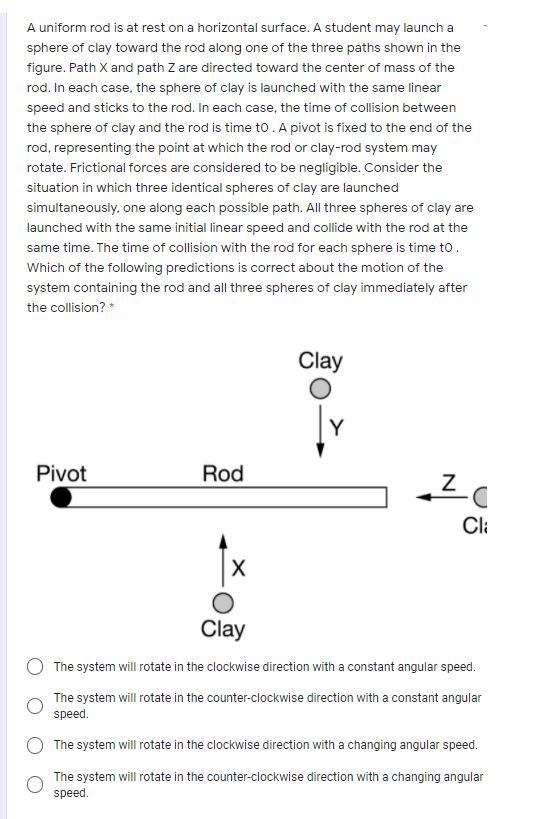A uniform rod is at rest on a horizontal surface. A student may launch a sphere of clay toward the rod along one of the three paths shown in the figure. Path X and path Z are directed toward the center of mass of the rod. In each case, the sphere of clay is launched with the same linear speed and sticks to the rod. In each case, the time of collision between the sphere of clay and the rod is time to . A pivot is fixed to the end of the rod, representing the point at which the rod or clay-rod system may rotate. Frictional forces are considered to be negligible. Consider the situation in which three identical spheres of clay are launched simultaneously, one along each possible path. All three spheres of clay are launched with the same initial linear speed and collide with the rod at the
A uniform rod is at rest on a horizontal surface. A student may launch a sphere of clay toward the rod along one of the three paths shown in the figure. Path X and path Z are directed toward the center of mass of the rod. In each case, the sphere of clay is launched with the same linear speed and sticks to the rod. In each case, the time of collision between the sphere of clay and the rod is time to . A pivot is fixed to the end of the rod, representing the point at which the rod or clay-rod system may rotate. Frictional forces are considered to be negligible. Consider the situation in which three identical spheres of clay are launched simultaneously, one along each possible path. All three spheres of clay are launched with the same initial linear speed and collide with the rod at the
Physics for Scientists and Engineers: Foundations and Connections
1st Edition
ISBN:9781133939146
Author:Katz, Debora M.
Publisher:Katz, Debora M.
Chapter10: Systems Of Particles And Conservation Of Momentum
Section: Chapter Questions
Problem 18PQ: Two metersticks are connected at their ends as shown in Figure P10.18. The center of mass of each...
Related questions
Question
100%
Please refernece attachment. See image for more information.

Transcribed Image Text:A uniform rod is at rest on a horizontal surface. A student may launch a
sphere of clay toward the rod along one of the three paths shown in the
figure. Path X and path Z are directed toward the center of mass of the
rod. In each case, the sphere of clay is launched with the same linear
speed and sticks to the rod. In each case, the time of collision between
the sphere of clay and the rod is time to. A pivot is fixed to the end of the
rod, representing the point at which the rod or clay-rod system may
rotate. Frictional forces are considered to be negligible. Consider the
situation in which three identical spheres of clay are launched
simultaneously, one along each possible path. All three spheres of clay are
launched with the same initial linear speed and collide with the rod at the
same time. The time of collision with the rod for each sphere is time to.
Which of the following predictions is correct about the motion of the
system containing the rod and all three spheres of clay immediately after
the collision? *
Clay
Y
Pivot
Rod
Cli
Clay
The system will rotate in the clockwise direction with a constant angular speed.
The system will rotate in the counter-clockwise direction with a constant angular
speed.
The system will rotate in the clockwise direction with a changing angular speed.
The system will rotate in the counter-clockwise direction with a changing angular
speed.
Expert Solution
Step 1
Required :
Motion of the rod.
The clay in the z direction will have no impact on the rotation of the rod, because the force is in line with the direction of the rod.
The clay in the x direction will move the rod in anti clockwise direction.
Trending now
This is a popular solution!
Step by step
Solved in 2 steps

Knowledge Booster
Learn more about
Need a deep-dive on the concept behind this application? Look no further. Learn more about this topic, physics and related others by exploring similar questions and additional content below.Recommended textbooks for you

Physics for Scientists and Engineers: Foundations…
Physics
ISBN:
9781133939146
Author:
Katz, Debora M.
Publisher:
Cengage Learning

University Physics Volume 1
Physics
ISBN:
9781938168277
Author:
William Moebs, Samuel J. Ling, Jeff Sanny
Publisher:
OpenStax - Rice University

Physics for Scientists and Engineers with Modern …
Physics
ISBN:
9781337553292
Author:
Raymond A. Serway, John W. Jewett
Publisher:
Cengage Learning

Physics for Scientists and Engineers: Foundations…
Physics
ISBN:
9781133939146
Author:
Katz, Debora M.
Publisher:
Cengage Learning

University Physics Volume 1
Physics
ISBN:
9781938168277
Author:
William Moebs, Samuel J. Ling, Jeff Sanny
Publisher:
OpenStax - Rice University

Physics for Scientists and Engineers with Modern …
Physics
ISBN:
9781337553292
Author:
Raymond A. Serway, John W. Jewett
Publisher:
Cengage Learning

Physics for Scientists and Engineers
Physics
ISBN:
9781337553278
Author:
Raymond A. Serway, John W. Jewett
Publisher:
Cengage Learning

Principles of Physics: A Calculus-Based Text
Physics
ISBN:
9781133104261
Author:
Raymond A. Serway, John W. Jewett
Publisher:
Cengage Learning